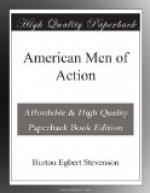The British had no suspicion of their danger, and they thought the first patter of bullets against the palisades the usual friendly salute from an Indian hunting party. But they were soon undeceived, and answered the rifles with ineffective fire from their two small cannon. All night the fight continued, and at dawn an Indian war-party, which had been ravaging the Kentucky settlements, entered the town, ignorant that the Americans had captured it. Marching up to the fort, they suddenly found themselves surrounded and seized. In their belts they carried the scalps of the settlers—men, women and children—they had slain, and, infuriated at the sight, the Americans tomahawked the savages, one after another, before the eyes of the British.
Then Clark sent to the fort a peremptory summons to surrender, adding, that “his men were eager to avenge the murder of their relatives and friends and would welcome an excuse to storm the fort.” To the British, it seemed a choice between surrender and massacre. They had seen the bloody vengeance wreaked upon their Indian allies, and they had every reason to believe that they would be dealt with in the same manner, since it was they who had set the Indians on. Clark was himself, of course, in desperate straits, without means for carrying on a successful siege, but the British were far from suspecting this, and at ten o’clock on the morning of February 25, 1779, marched out and stacked arms, while Clark fired a salute of thirteen guns in honor of the colonies, from whose possession the Northwest was never again to pass.
For eight years longer, Clark devoted his life to protecting the border from British and Indian invasion. The war over, he returned to Kentucky, and took up his abode in a little log cabin on the Ohio near Louisville. He was without means, and a horrible accident marred his last years, for, while alone in his cabin, he was stricken with paralysis, and fell with one of his legs in the old-fashioned fire-place. There was no one to draw him out of danger, and before the pain brought him partially to his senses, his leg was so badly burned that it had to be amputated. There were no anaesthetics in those days, but while the leg was being removed, a fife and drum corps played its hardest at the bedside, and the doughty old warrior kept time to the music with his fingers.




